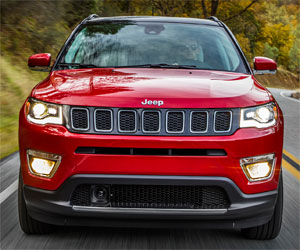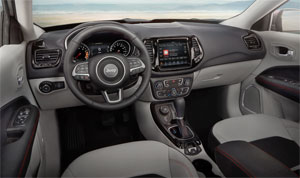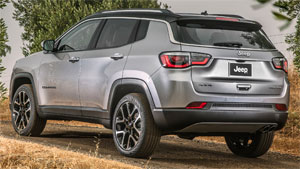2017 Jeep Compass
With the expanding Jeep lineup recently adding the subcompact Renegade, one might have thought the aged Compass’ was on its way out. Well not so fast, as Jeep has just released an all-new compact Compass, making for a two-pronged small SUV attack from the brand. Plus, this Compass claims to have shed its “near Jeep” reputation. So is the new Compass for “real”? Let’s all be the judge of that.
If you thought there wasn’t enough room in the Jeep lineup for another crossover between the Renegade and the Cherokee, well you’re wrong, as that spot is now filled by the reborn 2017 Jeep Compass.
And while that might not exactly cause mass cheering around your workplace or ours, it will certainly create some buzz in plenty of the over 100 countries that it will be sold in.
The Compass still rides on a front-wheel-drive based chassis, though no longer the Dodge Caliber’s; rather, the Fiat derived Jeep Renegade’s.
There’s a choice of two all-wheel-drive systems, Active Drive and Active Drive Low. Trailhawk editions come with Active Drive Low, which adds low range and Rock mode with Hill-Descent Control to the standard Selec-Terrain.
 The Compass’ exterior design is without a doubt much more SUVish in appearance than the compact wagon of before; drawing more cues from the larger Grand Cherokee than chassis-mate Renegade.
The Compass’ exterior design is without a doubt much more SUVish in appearance than the compact wagon of before; drawing more cues from the larger Grand Cherokee than chassis-mate Renegade.
The front end is still tall and chunky looking, with the shortened 7-slot grille stretching fully between the black-trimmed headlights. A black-painted roof is optional, as are LED tail lights.
And, for those Jeep Easter Eggs we’re not supposed to fully understand, there’s a lizard molded into the cowl, and a Loch Ness monster on the rear window.
We do understand FCA’s Tigershark 2.4-liter I4; our only engine choice for now. Here it produces 180-horsepower and 175 lb-ft. of torque. Walking up the trim levels will move you from 6-speed manual, to 6-speed automatic, and ultimately 9-speed auto.
The interior appears almost upscale, more so in Limited trim; with little Jeep quirkiness to be found. Front seat space is ample, made more so by a very low console for an almost airy feel.
Seat cushions felt firm initially; but after a long day in the saddle, they proved to be very comfortable.
Rear seat space is good on headroom, adequate on legroom, but the cushions are harder and flatter.
Even base models feature a UConnect touchscreen center dash, but upgrading to navigation gets you a much larger 8.5-inch version.
 A handy power lift gate is optional. Behind it is a good 27.2 cu-ft. of cargo space. Split, nearly flat folding rear seats expand that to a respectable 59.8 cu-ft.
A handy power lift gate is optional. Behind it is a good 27.2 cu-ft. of cargo space. Split, nearly flat folding rear seats expand that to a respectable 59.8 cu-ft.
As for driving; well, The Compass never really feels overpowered, merely adequate.
And that 9-speed still seems to be a powertrain weak link. It seldom felt like it was in the right gear at the right time, and was rather slow to make any changes.
We found the ride to be, somewhat surprisingly, very smooth, even with the Limited’s 18-inch wheels. Interior noise levels suffered a bit from wind noise around the windows. The kind that makes you keep checking to see if they’re all the way up.
Always wanting to prove their off-road merits, Jeep arranged for backwoods time in Northern California. We hit some real trails, not just specially created obstacles as many carmakers like to send you through. We’re not talkin’ hardcore stuff here, but this little Compass Trailhawk is clearly more capable than anything else in its class.
But, our advice is that unless you plan to do lots of off-roading, skip the Trailhawk and stick with still-capable lesser trims and save some money. Or, spend about the same and go for luxury with Limited trim.
 It will take adding a few option packages, but comprehensive safety systems are available; including Full-speed Collision Warning Plus with Advanced Brake Assist.
It will take adding a few option packages, but comprehensive safety systems are available; including Full-speed Collision Warning Plus with Advanced Brake Assist.
Regardless of drivetrain, Government Fuel Economy Ratings are all very close to the front-wheel-drive manual’s 23-City, 32-Highway, and 26-Combined. Our mileage loop was right on at 25.9 MPG.
The Energy Impact Score is 12.7-barrels of annual oil consumption with 5.6-tons of CO2 emitted.
Compass base pricing ranges from a Sport at $22,090 to Limited at $30,090. But be advised, there are some 2017 Compass carryovers from last generation on dealer’s lots. Trust us, the new one is the one you want.
With crossover and SUV sales showing no sign of slowing down, FCA’s Jeep brand could probably put just about anything out there and be successful with it. That’s not what they did with the genuinely all-new 2017 Jeep Compass. It’s miles better than its predecessor. And, with Jeep more and more a global brand, this small and capable family runabout is certain to have loads of appeal both home and abroad.
Specifications
- Engine: 2.4 liter
- Horsepower: 180
- Torque: 175 lb-ft.
- EPA: 23 mpg city / 32 mpg highway
- Energy Impact: 12.7 barrels of oil/yr
- CO2 Emissions: 5.6 tons/yr
2024 Toyota Land Cruiser
Toyota’s Go Anywhere Globetrotter Returns To U.S.
Every once in a while, we all need a reset. A time to get back to basics and prioritize the things that really matter. Well, for the Toyota Land Cruiser that time is now. So, let’s find out if that means bigger and better things for Toyota’s iconic off-roader.
The Toyota Land Cruiser’s status among the global off-road community is legendary, and it’s hard to imagine there’s any corner of the earth where a Land Cruiser hasn’t kicked up a little dust or mud. Well, 2024 sees the return of the Land Cruiser to the U.S. market after a 3-year hiatus, getting a major reset for the journey.
The reset comes mostly by no longer being based on the large three-row “300-series” chassis, but a new version of the smaller “200-series,” now known as the J250. As with the latest Tacoma, it uses the Tundra pickup’s full-size steel frame.
While the main Land Cruiser model, which goes by simply Land Cruiser, is packed full of luxury and convenience features, there is also a stripped-down model known as the 1958, honoring the first year the Land Cruiser made landfall here in North America. And it is that 1958 we have here, and we were glad to see it, as it also celebrates the original’s back-to-basics approach as a blank canvas for you to personalize as you tackle more and more adventures.
Not that it’s fully stripped down, as 8-inch touchscreen infotainment, a 7-inch full-color multi-information display, and automatic climate control are still standard. Plus, some seriously durable materials, and great heated cloth front seats that throw off some get serious 1990s Tacoma vibes.
But outside, there’s a definite lack of flashy trim and basic looking 18-inch wheels with Yokohama Geolander all-season tires; plus, big chunky bumpers and tilt-up back glass, which is a rarity that we appreciate. Though there is a little too much plastic in places that are sure to see some abuse if you do any significant off-roading.
It even feels a little rough around the edges, but for us it just adds to the rugged old-school utility vibe in a good way.
We did just that, both here in the Mid-Atlantic as well as in the California desert; and while there are some tech-forward driving aids, the actual hardware is in most cases plenty to get things done. That includes standard full-time dual-range four-wheel-drive, locking center and rear diffs, and 8.7-inches of ground clearance. A front stabilizer bar disconnect is also available to allow for increased articulation.
Who needs a V6 or even a V8 when you’ve got Toyota’s i-FORCE MAX setup at your disposal with 326 horsepower and 465 lb-ft of torque coming from a 2.4-liter turbo-four with an electric motor sandwiched between the engine and its eight-speed automatic transmission. Low speed torque delivery is impressive. It even feels a little rough around the edges, which may be a turn off to some, but for us it just adds to the rugged old-school utility vibe in a good way.
And it certainly feels quicker than an off roader needs to be, with an instant torque dump as soon as we eased on the throttle at our Mason Dixon test track; helping us get to 60 in 8.1 seconds and through the quarter-mile in 16.3 seconds at 86 mph. Considering the Land Cruiser’s terrain conquering mission, it behaved quite well in our handling course; it was plenty responsive to inputs, with less body roll than we expected and plenty of grip from the tires. The steering was light and quick but as expected didn’t provide much feel. Other than significant nosedive, braking performance was exceptional. Only 107-feet to panic stop us from 60 mph.
With the shift to the smaller size, there’s no more third row available, and cargo capacity now comes in at 46.2 cubic-feet with a max of a still healthy 82.1. Now, the best part of the Land Cruiser’s return is the entry price of $57,445. That’s about 30-grand less than what the last Land Cruiser went for back in 2021.
Whether it’s over the top fashion trends, mullets, or zombies; just when you think they’re dead, they come roaring back to life. Of course, we’re much happier to see the resurrection of this 2024 Toyota Land Cruiser than any of those things. Toyota is one brand that still recognizes the value of full-framed rugged rigs and has also acknowledged that sometimes less really is more. The Godfather of Toyota off-roading is back and better than ever.







